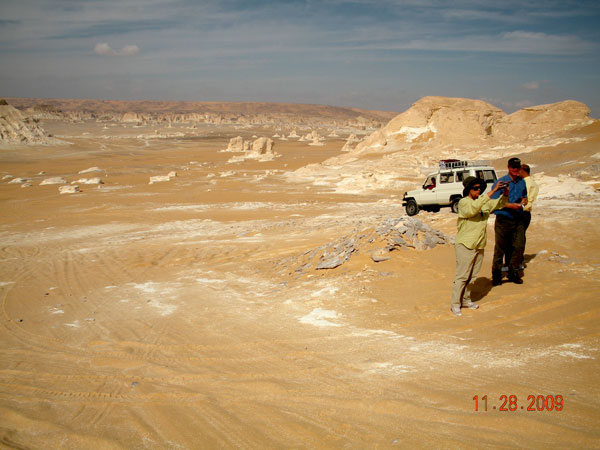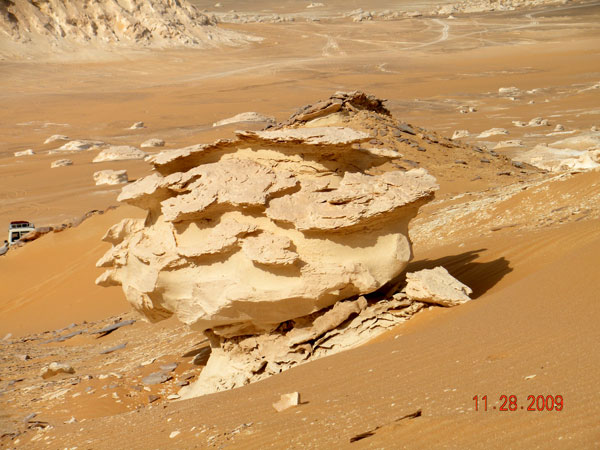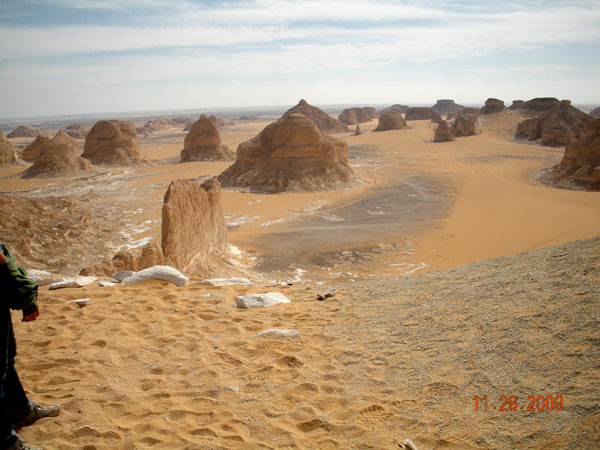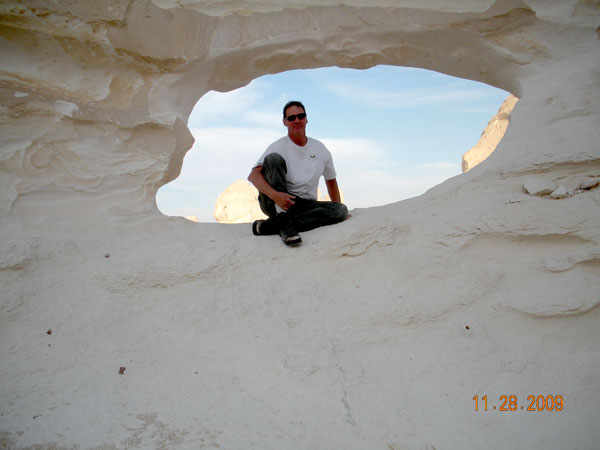Saturday, 28 November 2009
Okay, I realize that’s a tortured desert metaphor with a limited recognition factor, but three days in the desert will do strange things to one’s sensibilities. Just think about the source for my title if you doubt me. The guys who wrote that song had obviously spent too much time in the sun. The night proved not to be as cold as expected and with two blankets instead of one, and my Fulbright cap on my head, I was actually quite comfortable. One hip was complaining a bit since it spent most of the night crushed against the sand, but once I got up and moving, its mood improved.
 There were a few high clouds in the sky but they weren’t thick enough to block the sunlight. The camp was still relatively quiet at this early hour. The music the previous evening had gone on until almost midnight and many people were sleeping in, if they could. The chef was up and slowly getting breakfast on the table. Someone was stirring a campfire to life. The campsite was beginning to look a little shopworn; bits of litter peeked from the sand here and there; the port-a-potty was filling up; the chef’s white jacket was smudged with grease and soot. Nonetheless, there was soon hot water for tea and Nescafe and the day looked a bit brighter after a cup or two.
There were a few high clouds in the sky but they weren’t thick enough to block the sunlight. The camp was still relatively quiet at this early hour. The music the previous evening had gone on until almost midnight and many people were sleeping in, if they could. The chef was up and slowly getting breakfast on the table. Someone was stirring a campfire to life. The campsite was beginning to look a little shopworn; bits of litter peeked from the sand here and there; the port-a-potty was filling up; the chef’s white jacket was smudged with grease and soot. Nonetheless, there was soon hot water for tea and Nescafe and the day looked a bit brighter after a cup or two.
We had been told that today would be a day of hiking and limited activity and I was actually looking forward to relaxing a bit. Over breakfast, which was a reprise of yesterday’s, our little group talked about what we might do. The “in” joke was that Jamie’s expedition deal was to have included a camel ride, but with no camels in evidence, we ribbed him about his misfortune. The head of Badawiya had stopped by the camp on Friday and talked with us for a short while. We told him that we were very pleased with our arrangements and he expressed some concern about the lack of a firm plan for Saturday, but we had told him not to worry.
Apparently we hadn’t been convincing, however, for after breakfast Ashari came and told us that we’d be doing some more four-wheeling today. Ashari had a miserable cough and we felt guilty about making him drive us all over, but he insisted that we go, so we gathered our bags and climbed into the Toyota. The plan was that today we would head into the section of the White Desert that lay to the northwest of the desert road. As we drove across the desert in the general direction of the highway between Bahriya and Farafra (one gets one’s bearings after a while, even in this immense space), we consulted Jamie’s more or less trusty map of the Inner Oases that he had purchased in Bawiti. He told us that we had been camping at one edge of the White Desert and that, through conversations with our guides and studying the map, we had yet to see the most spectacular of the sights the White Desert had to offer. To add to the excitement, he told us that the area we would visit today was a protected area and less visited than other parts of the park.
We soon encountered the pavement and turned Northeast in the direction of Bahriya. We didn’t stay on the macadam for long, however. After a few miles we noticed a vehicle parked on one side of the road; as we got closer, we saw that it was some sort of official car with a uniformed man seated inside. Behind the car was a stone marker next to a dirt track. Ashari waved to the guy in uniform, he waved back, and we crunched onto the gravel of the desert. Our route took us over rougher terrain than we had experienced the day before and we found ourselves descending on a steep track into a depression marked by huge white boulders and sharp ridges of rock that caused the Toyota to lurch from side to side as we passed over them. We continued down the track for twenty minutes or so until we came to a broad basin surrounded by towering cliffs and lower plateaus of white rock. We drove across the bottom of this space and then assaulted a steep bank of sand spilling out of a gap between two promontories. The sand was hard packed for most of the climb, but short of the summit, Ashari, turned the wheel and pulled up. He suggested we walk to the top for a view.


We climbed out and had a look around. The view from the slope across the basin in the direction we had come was marvelous, with the escarpment in the distance glowing a dull red against the white ridges and monoliths closer to us. The sand that had blown over the ridge was deeper here and its effect on the softer white rock was clearly in evidence as we approached the summit. We reached the top and held our collective breaths. Before us stretched a broad chasm deeper than the one we had just crossed and holding a series of towering rock pillars that called forth images of Monument Valley in Utah. Deep sand flowed around the bases of these massive towers and patches of exposed white rock appeared as snow from this distance. The gorge extended for miles, the far side of the basin just visible through the haze. We stood in awed silence. Despite the knowledge that no photo could do justice to the view, we tried to capture it.



After a time, Ashari honked and we returned to the car. Descending the slope, we turned west and drove further into the desert. There were many more of the chalk formations here but there was also a greater amount of the black iron pyrite fragments we had seen the previous day. We decided that they must have been the result of some monstrous cataclysmic volcanic eruption tens of millions of years ago. The contrast between the white chalk and the black stones was very dramatic. The black stones lay all about; some were pencil-like, broken into stubby lengths; others were round. Still others were rounded on one end and split open, shaped like parabolas with hollow interiors encrusted with small reddish crystals. There were starburst shapes and fragments of all sorts.

 At each stop we competed with each other in discovering the most unusual example. Ginger returned to Cairo with a pack weighing twice what it did when she set out. There were places where the black rocks stuck up out of the white stone like mails in a piece of wood; frequently, on exposed rock faces, the black stones were visible, embedded in the chalk. This material must have rained down on the ancient sea and, cooling as it sank, stuck into the still soft sediment at the sea bottom where it was eventually covered by eons of crustaceous carcasses. Elsewhere, we found the remnants of ancient seashells embedded in the chalk as well. Some of the black stones even bore the impressions of seashells. Glad I wasn’t around for that “weather event.”
At each stop we competed with each other in discovering the most unusual example. Ginger returned to Cairo with a pack weighing twice what it did when she set out. There were places where the black rocks stuck up out of the white stone like mails in a piece of wood; frequently, on exposed rock faces, the black stones were visible, embedded in the chalk. This material must have rained down on the ancient sea and, cooling as it sank, stuck into the still soft sediment at the sea bottom where it was eventually covered by eons of crustaceous carcasses. Elsewhere, we found the remnants of ancient seashells embedded in the chalk as well. Some of the black stones even bore the impressions of seashells. Glad I wasn’t around for that “weather event.”
We lunched up against a cliff face in a small hollow behind a sand dune, out of the wind. A huge overhang above our heads made me a little nervous; I had convinced myself that the rock was just waiting for us to show up so it could break loose and wreak geological vengeance upon us. But we finished our meal with its judgment reserved for a while longer.  We continued driving through the depression, entering a flat area with row upon row of white stone pillars which we had to slalom our way through. At times I doubted Ashari’s sense of distances as we squeezed through gaps that I feared would leave us jammed between two walls of rock, but he piloted us through without so much as a scratch on the doors. t a relatively open space, he stopped and let us out to take some photos and explore a bit. Within minutes, Jamie had disappeared and I saw how easily one could become disoriented and lost in this place. The rock formations were ever-changing; there were several in this spot that looked like nothing so much as a piece of mille feuille pastry drizzled with a sugary icing. More wondering about what sort of geological process had created such masterpieces. Every turn revealed something new and surprising.
We continued driving through the depression, entering a flat area with row upon row of white stone pillars which we had to slalom our way through. At times I doubted Ashari’s sense of distances as we squeezed through gaps that I feared would leave us jammed between two walls of rock, but he piloted us through without so much as a scratch on the doors. t a relatively open space, he stopped and let us out to take some photos and explore a bit. Within minutes, Jamie had disappeared and I saw how easily one could become disoriented and lost in this place. The rock formations were ever-changing; there were several in this spot that looked like nothing so much as a piece of mille feuille pastry drizzled with a sugary icing. More wondering about what sort of geological process had created such masterpieces. Every turn revealed something new and surprising.


 Our penultimate stop was in a canyon surrounded by towering white cliffs. To one side was a jagged pillar of white rock easily 200 feet high; at its base was a hole that allowed us to crawl through from one side to the other. I tried to keep from my consciousness the fact that several hundreds of thousands of tons of rock sat above us. The final leg of our journey brought us up out of the basin and across the paved road to another area where white rock pillars dominated the landscape. There was again a myriad of shapes and forms stretching away, but in truth this dimmed in comparison to what we had seen earlier in the day. Still, it was an impressive way to end our tour.
Our penultimate stop was in a canyon surrounded by towering white cliffs. To one side was a jagged pillar of white rock easily 200 feet high; at its base was a hole that allowed us to crawl through from one side to the other. I tried to keep from my consciousness the fact that several hundreds of thousands of tons of rock sat above us. The final leg of our journey brought us up out of the basin and across the paved road to another area where white rock pillars dominated the landscape. There was again a myriad of shapes and forms stretching away, but in truth this dimmed in comparison to what we had seen earlier in the day. Still, it was an impressive way to end our tour.
A short ride across the desert brought us back to camp, which stood mostly empty now. The Egyptians, we learned, were spending the last night of their holiday in the more commodious hotel in Farafra and the other Americans, those of the projected computer animations, had arranged to spend their last night in the desert at a different campsite, one with new projection opportunities, no doubt, so we had the place to ourselves pretty much. Our dinner was taken together with members of the camp staff, which we appreciated, since it gave us a chance to interact more informally with our hosts.
But the campsite looked awfully deserted (no pun intended…) with so few of us to occupy all that space. There was only a small campfire tonight and preparations had clearly been underway in our absence to break the campsite down and move it as soon as we had departed. None of us were saddened by this; campsites had been coming and going in the desert for millennia and most traces of ours would soon disappear as well. We crawled off to bed having extorted one advantage from the departure of our camp-mates: we each got an extra mattress to put between our bodies and the hard desert floor. Perhaps that was the reason we all slept well, or maybe it was just our bodies finally making the adjustment to sleeping on the ground.